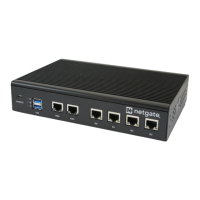Product Manual, TNSR 19.02
This sets an address, brings up the interface, and sets a description to serve as a reminder of the interface identity &
purpose.
Substitute a different Private IP address/mask and description as needed.
Configure LAN interface:
1. Discover the assigned IP address from the Azure CLI.
$ az network nic show \
-g TNSR-Resource-Group \
-n TNSR-LAN-nic \
--query "ipConfigurations[].privateIpAddress" \
-o tsv
10.5.1.4
2. Configure the interface in the TNSR CLI.
TNSR-Instance1 tnsr(config)# interface NetVSC3
TNSR-Instance1 tnsr(config-interface)# ip address 10.5.1.4/24
TNSR-Instance1 tnsr(config-interface)# enable
TNSR-Instance1 tnsr(config-interface)# description TNSR-Instance1 LAN
TNSR-Instance1 tnsr(config-interface)# exit
Again, substitute the interface Private IP address/mask and description as needed.
Check the interface status in TNSR again by typing show interface.
TNSR-Instance1 tnsr# show interface
Interface: NetVSC2
Description: TNSR-Instance1 WAN
Admin status: up
Link up, 100 Mbit/sec, full duplex
Link MTU: 9206 bytes
MAC address: 00:0d:3a:41:f6:b1
IPv4 Route Table: ipv4-VRF:0
IPv4 addresses:
10.5.0.4/24
IPv6 Route Table: ipv6-VRF:0
counters:
received: 480 bytes, 8 packets, 0 errors
transmitted: 822 bytes, 9 packets, 0 errors
8 drops, 0 punts, 0 rx miss, 0 rx no buffer
Interface: NetVSC3
Description: TNSR-Instance1 LAN
Admin status: up
Link up, 100 Mbit/sec, full duplex
Link MTU: 9206 bytes
MAC address: 00:0d:3a:41:f7:20
IPv4 Route Table: ipv4-VRF:0
IPv4 addresses:
10.5.1.4/24
IPv6 Route Table: ipv6-VRF:0
counters:
received: 0 bytes, 0 packets, 0 errors
transmitted: 892 bytes, 10 packets, 0 errors
0 drops, 0 punts, 0 rx miss, 0 rx no buffer
1.2. Cloud Platforms 55

